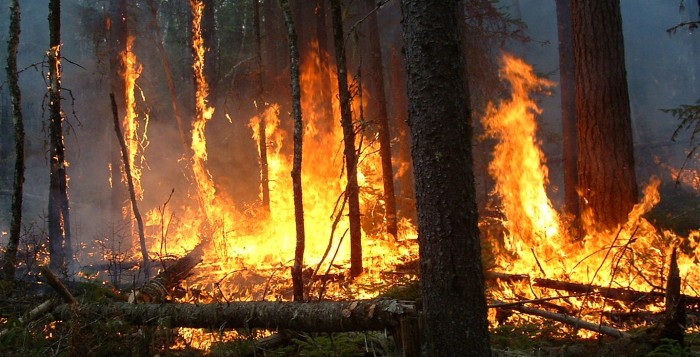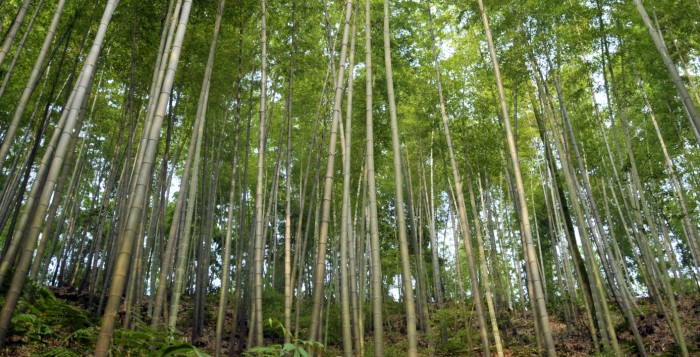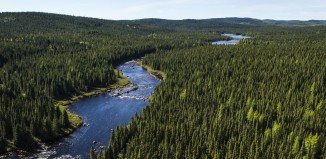While certainly a threat to public safety and property, forest fires have an important role to play in the life of a forest. Here are five answers to the big questions surrounding wildland fires:
- How do fires start?
Lightning is often the cause of wildland fires in more remote regions during the summer when dry conditions can persist. But Natural Resources Canada (NRCan) estimates that more than half of a season’s fires can be attributed to human causes like a spark from machinery to carelessness in the form of unattended campfires, discarded cigarettes and uncontrolled yard waste burns.[2] But for Canada’s boreal forest, the main ignitor is lightning.
See a live map of current lightning activity in Canada.
- How do they spread so quickly?
Beyond a source of ignition, wildland fires also need dry fuel and hot, dry, windy weather. And to continue to burn, they need heat, oxygen, and fuel (this is known as the fire triangle). Once ignited, fires can move quickly – up to 23 kph by some estimates.[3] And depending on the amount and type of fuel available, the weather and the topography, a fire can continue to spread. The heat from the existing burn causes the moisture in the adjacent fuel to evaporate so that it becomes easier to ignite. Wind provides the flames with oxygen and pushes the fire across a landscape at a faster rate. A large fire will also create a wind of its own, sometimes as much as 10 times faster than the ambient wind, which will propel embers high into the air to start fires in other areas.[4]
- Are all fires as dramatic as the images we see in the news?
No. There are essentially three different types of fires. The ones you see most often in images and news reports are called crown fires because they burn up to the top of a tree. These ones are considered most dangerous. Surface fires burn fuel elements like dried leaves, branches and pine needles on the forest floor. They tend to be easier to control and put out. The last one, the ground fire, is a subsurface fire that can even occur underground where there are deep accumulations of dead vegetation that have become dry enough to burn. These ones tend to smoulder for long periods.
Watch a high-intensity crown fire from the ground as it moves through an area.
- What is the role of fire in forest ecology?
In a word, it’s about diversity. And particularly for the boreal, which is composed of everything from pure deciduous to mixed deciduous-coniferous to pure coniferous. Decay doesn’t occur as quickly under the boreal’s cool temperate conditions as it might in warmer, more humid climates so fire is a natural way to convert the branches, logs and leaves on the ground to a mineral-rich ash. This releases and recycles nutrients.
The gaps in the forest created by fire also allow sun to penetrate and stimulate the growth of pioneer species like aspen, white birch, jack pine and lodgepole pine. If fire does not occur in this same forest over the next 100 years, black spruce will flourish in the shade these pioneer species provide.
And as birds carry seeds to new areas, a patchwork of vegetation develops, populated by different species at various levels of maturity. By rearranging vegetation, fires support the formation of diverse ecosystems that are home to a variety of populations of insects, mammals and birds.
- When is a fire simply allowed to burn?
It generally comes down to whether the fire poses a risk to human life and property. For most of the 20th century, forest fires were seen as a destructive force that needed to be suppressed. And we were generally successful. But we’ve since come to understand that fire, like wind and water, is just another element of the ecosystem. Today’s forest fire strategies range from putting out a fire to actually setting fires on purpose (these are known as prescribed burns and are used to eliminate potential fuel sources).
Learn more about how Ontario air crews set prescribed fires.
Agencies responsible for fire suppression in an area have a number of tools available to them to assess the risk to humans and property. As NRCan explains, high-priority areas for protection include residential areas, high-value commercial forests and recreational sites. Low-priority sites are generally wilderness parks and remote forests of limited economic value—although protection of rare habitat, culturally significant areas and similar values will influence suppression decisions.[5]
[1] http://www.cbc.ca/news/canada/thunder-bay/forest-fire-season-quiet-in-ontario-compared-to-average-1.3227997
[2] http://www.nrcan.gc.ca/forests/fire-insects-disturbances/fire/13145
[3] http://science.howstuffworks.com/nature/natural-disasters/wildfire.htm
[4] http://science.howstuffworks.com/nature/natural-disasters/wildfire2.htm
[5] http://www.nrcan.gc.ca/forests/fire-insects-disturbances/fire/13157
The environmental impacts of making paper from ‘tree-free’ fiber sources can be similar and even higher than using wood pulp. Here’s why.
There’s a popular notion that paper made from non-forest sources like hemp, bamboo or kenaf offers a more sustainable alternative to paper made from wood pulp. In other words, if you choose tree-free paper you’re protecting the environment. But that’s an oversimplification of a fairly complex equation.
Most studies comparing the environmental impacts of paper made from wood and non-wood raw materials have found that the impacts are broadly similar, and in some cases even higher for crop based fibers, depending on what you consider. Simply put, relying on crops to produce paper and pulp is not a panacea, and avoiding the use of wood is not necessarily the best way to protect forests.
By working with a crop instead of a forest, we are replacing one raw material for another. Even the use of polypropylene or polyester to make ‘plastic’ paper must account for its raw material, i.e. petroleum, which carries important environmental costs – many of which are significantly higher than wood-derived paper.
It’s important to consider all aspects of working with a raw material – from how much water it takes to grow and make into paper, to how much energy goes into creating it, and what other useful products it can produce.
Fiber crops like bamboo, kenaf and hemp are used around the world, but the overall impact can be problematic if one is arguing that these are better than using wood fiber. This bears out even as we examine just a few factors. Here are four:
- Fiber crops need more water. Forests are cultivated over several years and are more resistant to variations in rainfall. Crops, however, can require a lot of water. Kenaf, for example, needs five inches of water a month. As for processing, a non-wood crop’s shorter fiber requires more water for processing. Since most of the water used in processing – whether for wood-fiber or non-wood fiber – is treated and returned to the environment, it’s not so much a matter of consumption as it is about water sensitivity. As such, non-wood fiber processing is not a good option in low water areas.
- Fiber crops use more energy to grow. Non-wood fiber crops are often cited as offering a better yield than their wood counterparts when comparing the energy used to process. And depending on circumstances, this can be the case. But crops require more inputs. The harvesting and cultivation of a crop is more intense than that of a forest because it happens more frequently. There is also a greater reliance on fertilizer, which is energy-intensive. In fact, one measure finds that up to 50% of the energy consumed for agricultural production is associated with the manufacture and distribution of fertilizers.
- Wood offers energy for the process and creates other products. Non-wood fibers have the advantage in mechanical pulping where they require less energy than wood fibers, but in chemical pulping, working with forest products has a number of strengths. Specifically, it has a lower reliance on fossil fuel generated electricity than non-wood fiber pulping. In fact, energy derived from wood’s liquor recovery typically produces about 50% of a North American pulp and paper mill’s energy needs. And pulping wood this way also yields other products such as tall oil and turpentine.
- Forests are a better use of land. Even a heavily managed tree plantation offers better habitat value, biodiversity, water quality protection and soil carbon storage than an agricultural crop. That’s because all of the harvesting, replanting, fertilization and even pesticide application is being done only once every several years. But in agriculture, this happens annually. Studies have shown that proximity to native forests is the biggest determinant of species richness (one measure of biodiversity represented by the number of plant and animal species in a given area), which means that managed forests have a big biodiversity advantage over agricultural areas .
- Annual crops can only be harvested once a year. A constant, year-round supply of fiber is a primary concern for paper mills, which is difficult to guarantee with non-wood fiber crops that are generally harvested just once a year. Developing storage capacity requires additional land, energy and resources, which would be significant considering that most non-wood fiber sources are high in volume and low in density when compared with wood.
Finally, there is a great irony to the use of crops in an effort to thwart deforestation. To save a tree, one might think it is best to derive paper from a crop. But tree harvesting in the U.S. is not depleting its forests. Rather, net tree growth has exceeded removal for over six consecutive decades. For the U.S., the greatest danger to forests remains land conversion , while in Canada agriculture urban development, transportation, recreation and hydroelectricity are the main deforestation drivers . In other words, if the demand for tree-free paper were to increase, forests may need to be cut down to convert timberland into farmland that will grow crops to make paper.
High carbon stock forests around the world have an important part to play in the capture, storage and release of carbon in the fight against global warming.
When people talk about greenhouse gas (GHG) emissions, one of the most maligned gases is carbon dioxide. Excess carbon in the atmosphere is not good, but carbon is one of the essential gases that make life on earth possible. Forests both store and release significant amounts of carbon as part of a natural cycle. And good forest management not only reduces a forest’s potential as a carbon source, it can also increase the effect of its carbon storage capacity.






